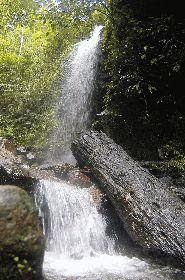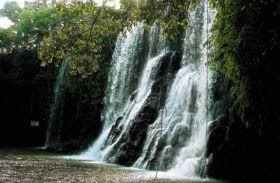March 22, 2007 was World Water Day. And guess what? Sunday we had no water! How ironic. Or how prescient.
 Not having water at least part of the time is the norm in Honduras; having running water 24 hours a day is a luxury.
Not having water at least part of the time is the norm in Honduras; having running water 24 hours a day is a luxury. Most times when we don't have water in our colonia (neighborhood), it is because the electricity goes out and once the neighborhood tank empties, there is no water until the electricity comes back on. Sometimes the pump breaks and parts have to be ordered from another city or country. Sometimes construction workers break a pipe and we have no water for a day or two until the pipe gets repaired. That is more frequent than you might imagine.
 In much of Honduras, though, there is no running water. In some areas big water tanker trucks deliver water to people who bring their buckets to the truck to fill up. Some companies, such as some of the coffee companies, supply water for free as a community service.
In much of Honduras, though, there is no running water. In some areas big water tanker trucks deliver water to people who bring their buckets to the truck to fill up. Some companies, such as some of the coffee companies, supply water for free as a community service.In other areas water is obtained daily from the nearest river, often by children who don't go to school as it is their responsibility to supply the daily water needs of the family. You can imagine how many trips it takes for young children who can only carry one or two gallon jugs of water at a time.
In many communities where there is running water, it is often for only one or two hours a day and then it is turned off. During the dry season when the rivers dry up, it's not unusual for many areas to go a week or even longer without any water at all. And then when it is turned back on, people may have an hour or two to fill all their water containers before it will be turned off again.
Some municipalidades (municipal governments) cycle the water between colonias because there isn't enough pressure to provide water to all at once. Interestingly, though, the wealthier neighborhoods rarely have this problem and almost always have water 24 hours per day. Sometimes during the rainy season, the water has to be turned off because of the amount of sediment in the rivers.
 The problem is getting worse all the time because of the continued deforestation of the mountains. The government has proclaimed a good part of the country's forests as protected areas and has strict laws about cutting trees, but for the most part, the laws are ignored and not enforced. We have seen big flat bed trucks full of huge freshly cut trees going down the highway on Saturday afternoons and Sundays when most of the government is shut down.
The problem is getting worse all the time because of the continued deforestation of the mountains. The government has proclaimed a good part of the country's forests as protected areas and has strict laws about cutting trees, but for the most part, the laws are ignored and not enforced. We have seen big flat bed trucks full of huge freshly cut trees going down the highway on Saturday afternoons and Sundays when most of the government is shut down. As you can imagine, every household maintains their own supply of water in whatever types of sinks and buckets and containers they can scrounge up, most without lids. Those who can afford it have an underground cistern or above ground tinaco (fiberglass water tank). The most commonly used container is a pila (an outdoor concrete washtub).
People have to maintain their own water to survive, but a side effect is that those containers can be a haven for mosquito larvae. Like most of Central America, Honduras has very high rates of malaria and dengue fever. I am very skeptical of any statistics because you have to consider that the majority of cases never get reported since many people can't afford go to a doctor, many others don't have access to a doctor, and there is no treatment for classic dengue anyway.
 While there are many measures that can and should be taken to reduce the incidence of these diseases, the need to store water is not such an easy one to solve.
While there are many measures that can and should be taken to reduce the incidence of these diseases, the need to store water is not such an easy one to solve.Many other diseases are prevalent because of the contamination of the water. There is always more sickness, especially among children, during the rainy season. The newspaper reports seem to imply that the increased illness is a direct result of rain. Many people actually believe that rain makes them sick, not realizing that the ground contamination of the water is a more likely culprit.
Rivers, streams, and the ocean are used as convenient trash receptacles throughout the country. Motor oil and every imaginable type of contaminant are poured into the sewer drains and on vacant properties to later drain into the rivers and ultimately the ocean. Open sewer lines are common and a big cause of water contamination.
While some of the problems can be blamed on those who may not know any better, much of the water and land contamination is a result of the mostly foreign-owned maquillas (factories) who no doubt have to follow stricter practices in their own countries. The runoff of chemicals from maquillas and foreign-owned mines, and chemical fertilizers, insecticides, and herbicides from the agricultural fields are a serious problem in this country.
It isn't only Honduran waters that are being damaged. According to the World Resources Institute:
"More than 80 percent of the sediment and 50 percent of the pollutants entering the coastal waters of the Mesoamerican Barrier Reef originate from human activities in nearby mountainous Honduras. The analysis is the first to determine the origin and volume of sediment and pollution that run off agricultural lands, via the region’s vast river networks, into the neighboring Gulf of Honduras and Caribbean Sea. The waters are home to the Mesoamerican Barrier Reef – the largest coral reef system in the Western Hemisphere, stretching for more than 600 miles, and shared by Belize, Guatemala, Honduras and Mexico."Throughout this article are photos of some of the beautiful water sources in Honduras as shown in a recent La Prensa article. It's hard to imagine that a country with so much water has none for many of its people.
Rainy season or dry season, there is always a problem getting water in Honduras. The problems will only get worse if the government continues to allow the deforestation of the mountains and doesn't take sanctions against those who contaminate the water we have left.



 Welcome to my Blogicito —
Welcome to my Blogicito — 







